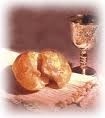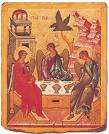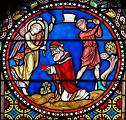| Next | Previous | Index | Tellout Home |
31. Communal Sacramental Meals
The Lord's Supper
 As Christianity developed, different kinds of communal sacramental meals, sometimes called the Eucharist, the Lord's Supper, Holy Communion, or the Mass, also appeared. They differed from one another in different places. However, for Christian families, participation in these was meaningful and essential, according to Carolyn Osiek and David L. Balch in "Families in the New Testament World - Households and House Churches."✞
As Christianity developed, different kinds of communal sacramental meals, sometimes called the Eucharist, the Lord's Supper, Holy Communion, or the Mass, also appeared. They differed from one another in different places. However, for Christian families, participation in these was meaningful and essential, according to Carolyn Osiek and David L. Balch in "Families in the New Testament World - Households and House Churches."✞
Upper Room
 The Lord's Supper was one important sacrament celebrated on Sunday, the first day of each week. This celebration was in continuity with the Jewish meals of Jesus with his disciples, especially the Last Supper in the Upper Room before Jesus' arrest. In Acts 2.42, we read, "When the day of Pentecost came, they were all together. Suddenly a sound like the blowing of a violent wind came from heaven and filled the whole house where they were sitting." Another lesser-known of the early sacramental meals is the "agape feast" or the "love feast." This feast is a combination of a supper for all and then followed by the Lord's Supper sacrament. It may have been the origin of the breaking of the bread in Acts 2.1-2, "They devoted themselves to the apostles' teaching and fellowship, to the breaking of bread and prayer." It may or may not be the same as the Holy Communion or Eucharist of today.✞
The Lord's Supper was one important sacrament celebrated on Sunday, the first day of each week. This celebration was in continuity with the Jewish meals of Jesus with his disciples, especially the Last Supper in the Upper Room before Jesus' arrest. In Acts 2.42, we read, "When the day of Pentecost came, they were all together. Suddenly a sound like the blowing of a violent wind came from heaven and filled the whole house where they were sitting." Another lesser-known of the early sacramental meals is the "agape feast" or the "love feast." This feast is a combination of a supper for all and then followed by the Lord's Supper sacrament. It may have been the origin of the breaking of the bread in Acts 2.1-2, "They devoted themselves to the apostles' teaching and fellowship, to the breaking of bread and prayer." It may or may not be the same as the Holy Communion or Eucharist of today.✞
Agape Meals
 There may also be a reference to communal sacramental meals in the Epistle of Jude 1.12, where Jude, the brother of Jesus, writes that inappropriate deeds are "spots on your agapes," but the textual variants make it unclear. When Ignatius stipulates that the bishop should sanction every genuine Eucharist, he went on to add two other events in the same category, Baptism and "Doing Agape," meaning taking part in the Agape Meal. Many think that the Eucharist and the Agape Meal were the same events in the early years, but they became distinct later. If so, they are already different by the early second century in Antioch and other parts of the province of Asia, where Ignatius (35-108 AD), who is called "the God-bearer" or "the fire-bearer," is writing. Ignatius was an Apostolic Father, student of John the Apostle, and the third Bishop of Antioch. He wrote a series of letters on ecclesiology or study of the church, the sacraments, and the bishop's role. In Rome, he was martyred by being fed to wild beasts.✞
There may also be a reference to communal sacramental meals in the Epistle of Jude 1.12, where Jude, the brother of Jesus, writes that inappropriate deeds are "spots on your agapes," but the textual variants make it unclear. When Ignatius stipulates that the bishop should sanction every genuine Eucharist, he went on to add two other events in the same category, Baptism and "Doing Agape," meaning taking part in the Agape Meal. Many think that the Eucharist and the Agape Meal were the same events in the early years, but they became distinct later. If so, they are already different by the early second century in Antioch and other parts of the province of Asia, where Ignatius (35-108 AD), who is called "the God-bearer" or "the fire-bearer," is writing. Ignatius was an Apostolic Father, student of John the Apostle, and the third Bishop of Antioch. He wrote a series of letters on ecclesiology or study of the church, the sacraments, and the bishop's role. In Rome, he was martyred by being fed to wild beasts.✞
Christian House Meal
 Tertullian's description of the Lord's Supper, the Eucharist, or the Agape Meal is sometimes called a ceremonial Christian house meal. "The Acts of Perpetua and Echeitos" is a historical account of Perpetua's passion before her death and that of her slave Felicitas in the Carthage arena in 203 AD. She writes this herself before her death, as described by Osiek and Balch. She relates that those in prison celebrated their last Christian house meal as an agape on the eve of their martyrdom. Tertullian (160-220 AD), a prolific writer in Carthage in Roman North Africa, describes agape meals as what we later know it had become, a meal held out of familial duty to help those in need, that is, to feed the hungry of the community. This Agape contrasts with what we know about the later Eucharist, reading, and teaching order. Tertullian's agape meal description follows the classical symposium order, first the house meal, then drinking and conversation or entertainment. In Tertullian's report, there is prayer, then the dinner with drinking, the washing of hands, lights brought in, then recitation of scripture and singing, ending again with prayer. There is no indication that what he is describing is also the Eucharist. Instead, it is an actual meal held in a private house, into which the less fortunate came for both physical and spiritual nourishment. As such, it probably takes the form of an extended family festival.✞
Tertullian's description of the Lord's Supper, the Eucharist, or the Agape Meal is sometimes called a ceremonial Christian house meal. "The Acts of Perpetua and Echeitos" is a historical account of Perpetua's passion before her death and that of her slave Felicitas in the Carthage arena in 203 AD. She writes this herself before her death, as described by Osiek and Balch. She relates that those in prison celebrated their last Christian house meal as an agape on the eve of their martyrdom. Tertullian (160-220 AD), a prolific writer in Carthage in Roman North Africa, describes agape meals as what we later know it had become, a meal held out of familial duty to help those in need, that is, to feed the hungry of the community. This Agape contrasts with what we know about the later Eucharist, reading, and teaching order. Tertullian's agape meal description follows the classical symposium order, first the house meal, then drinking and conversation or entertainment. In Tertullian's report, there is prayer, then the dinner with drinking, the washing of hands, lights brought in, then recitation of scripture and singing, ending again with prayer. There is no indication that what he is describing is also the Eucharist. Instead, it is an actual meal held in a private house, into which the less fortunate came for both physical and spiritual nourishment. As such, it probably takes the form of an extended family festival.✞
"Communal Sacramental Meals"
by Ron Meacock © 2021
| ^Top Page | Next | Previous |